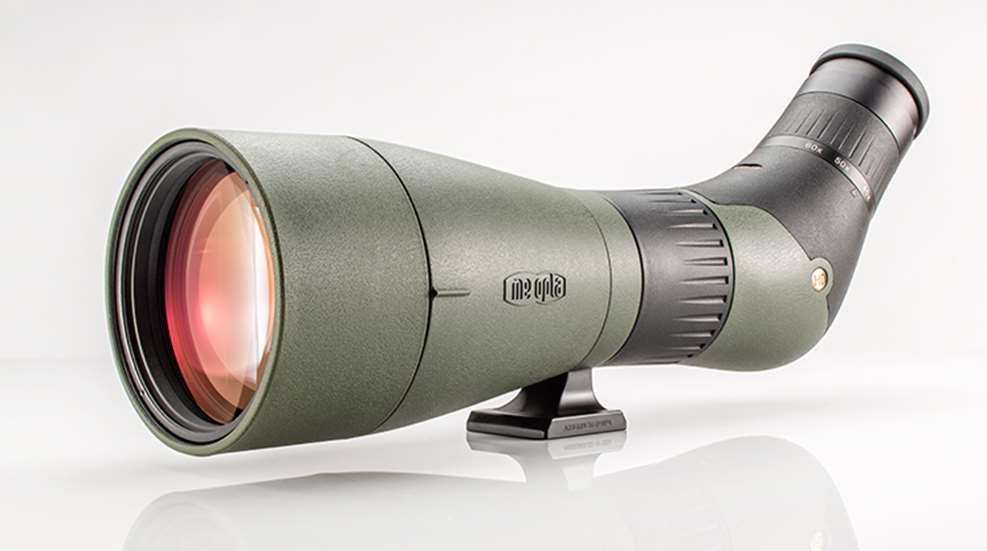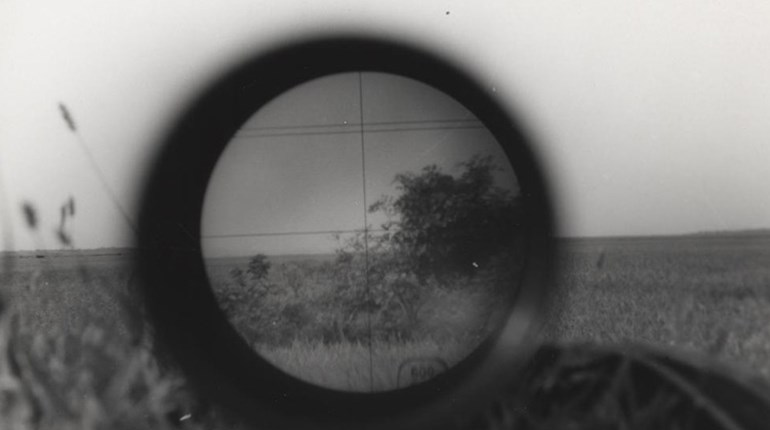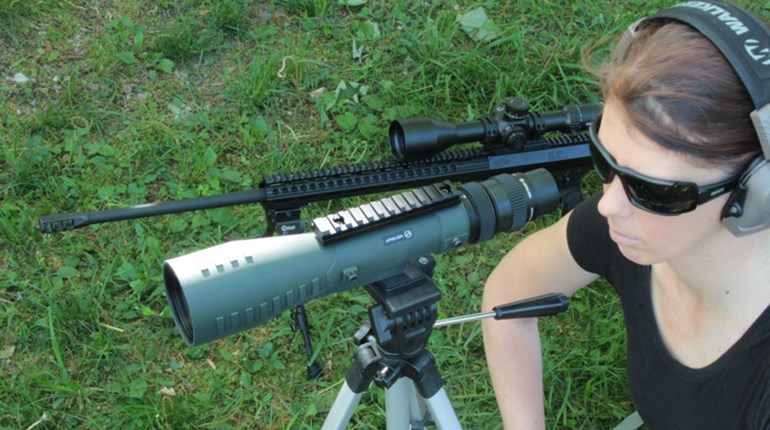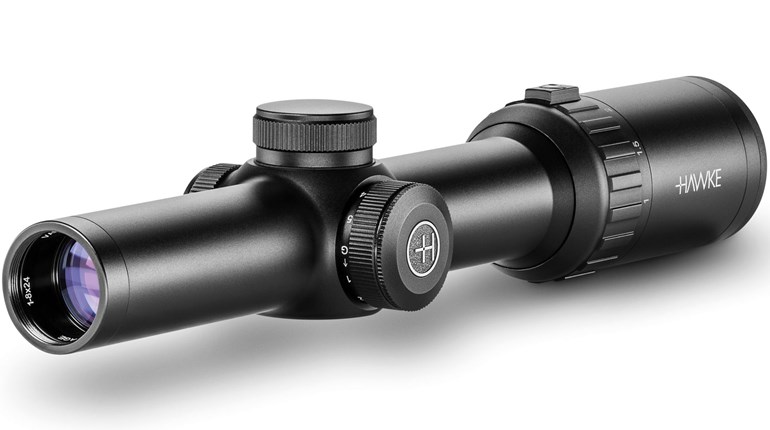
A spotting scope is one of those ancillary shooting and hunting accessories that isn’t essential—until you’ve used one.
“Holy … I can see his eyelashes!” my cousin declared as he peered at a deer for the first time at 50X.
Years later my shooting buddy Dustin used my spotter for the first time to check our 100-yard target for a .17-caliber bullet hole. “I see it! An inch left and two high. Wow, this will save a lot of walking.”
Most recently my friend George stared through my big spotter at a brushy mountainside. “You’re messing with me, right?” he questioned. There was a bedded whitetail in the view, 753 laser-measured yards away, but he didn’t believe it.
“See that black stump just left of the fir tree?” I asked. “Look just above it.”
“Oh. Oh! Wow. It is a deer! You’d never see it without this scope.” He nudged the focus wheel. “Hey, I can see its antlers. It’s got five on the left and … five on the right. This is fantastic. You can see every point.”
Yeah, a spotting scope isn’t essential—until you’ve seen what one can do. Then you lust to own one. So get one. But make it a good one like the Meopta MeoPro 80 HD, the latest iteration from one of the oldest, least-known stars in the “Eur-optic” world.
Meopta in the Czech Republic has been designing and building high-quality optical instruments for more years than most of us have been alive. The company also has been building them for many other brands, including some of the most recognized in the industry. Obscured for decades behind the Iron Curtain, Meopta now has expanded into a manufacturing, assembly and engineering facility in New York. This is where the affordable MeoPro 80 HD is put together from precision parts made in the company’s Czech facilities.
This armor-coated, black and green, 20X-60X-80mm instrument looks, feels and operates like a precision machine costing much more than its MSRP of $1,724.99. Built on a magnesium and aluminum body, the MeoPro 80 HD boasts a Schott glass prism cut, ground and polished to an angular deviation no greater than 2 arc seconds. That’s extremely precise and consistent. Lenses are also Schott glass, plus a high-definition fluoride glass objective lens designed to minimize color fringing via its extra-low dispersion refractive index. Proprietary MeoBright anti-reflection coatings on all air-to-glass surfaces knock light loss down to just .2 percent per surface, and a MeoShield coating on the external lenses hardens them against scratching and marring.
Convenience features include a push/pull sun shade, a twist-up eye cup that lets you rest your brow against the eyepiece without smudging the glass with your lashes, and a rotating tripod-mount collar that enables the barrel to rotate in a complete circle. This is extremely useful in conjunction with the 45-degree angled eyepiece, something hunters and shooters are finally beginning to appreciate.
While an angled eyepiece takes some getting used to because you’re not looking at your target on the same axis as the scope’s barrel, once you’ve mastered it, you begin to understand its advantages. A raised rib on the left side of the MeoPro’s barrel is supposed to be a sighting device. At first try this seemed wishful thinking, but I discovered that by rotating the scope to put this rib on top and carefully aligning it with my subject, I could find said subject at 20X by tilting the scope slightly higher than the initial alignment. After a few practice runs, I was getting on targets consistently and quickly.
Once aligned, the 45-degree eyepiece lets you sit comfortably behind the tripod-mounted scope without craning your neck and remain in place for extended, comfortable viewing. To share the view with a partner, spin the scope left or right in the tripod-mount collar. This moves the eyepiece out where a second person can easily access it without shifting the barrel/objective lens off target or forcing the first person to get up and out of the way. I’ve seen guides hide behind boulders, ease an angled-eyepiece scope over the rock and observe game while staying completely out of sight.
At the range you can set up the tripod just off one shoulder and merely lift your head from the rifle to the angled eyepiece to check targets. Reinhard Seipp, general manager at Meopta USA, mounts his iPhone to the eyepiece, puts it on camera mode and glances at the screen to see his hits. In video mode you can record your shots, and see hits, misses and sometimes even the bullet trace. Meopta sees so much potential in this ability that it includes with the 80 HD a MeoPix smartphone adapter.
One traditional feature this scope doesn’t include is an interchangeable eyepiece. Years ago shooters would screw different, single-power eyepieces to their scopes, changing out as needed. Today, most just use a zoom eyepiece. So why make it removable? Meopta saves considerable expense by building the 80 HD with a permanent 20X-60X eyepiece.
The foot of the tripod mount accepts screws with the standard 1/4x20 thread, but it also fits the popular Manfrotto-style clamp tripod head. Meopta sells a tripod with a quick-mount head for such convenience. Other mounting plates, like the Arca-Swiss size, can be affixed to the foot.
The MeoPro 80 HD is, as expected these days, nitrogen purged and sealed, and guaranteed waterproof/fogproof/dustproof. I didn’t submerge my sample to test this, but I compared its optical performance extensively against a top-of-the-line spotting scope costing $900 more. At 25X the MeoPro transmitted a slightly sharper, more saturated, higher-contrast image with no linear distortion (bending of straight lines) and no discernible color fringing. This advantage gradually diminished as power increased. After 40X, optical quality began to decline in the MeoPro while it seemed to improve in the higher-priced unit. From 40X-60X the MeoPro’s image certainly enlarged, but it decreased significantly in resolution. Even so, at 60X I was able to read the letters “TREK” on a bicycle parked in deep shade a block away. With the morning sun shining directly onto the objective lens, images remained flare-free and agreeably saturated. Fine details in shadowed cottonwood bark showed clearly even as yellow leaves glowed brightly with backlit sunlight.
This scope tends to be a fussy focuser. While the large barrel-mounted focus ring is rubbery, grooved, easy to access and smooth to turn, it seems to run past perfect focus, and then requires additional turning to come back to perfect. This is probably why some high-end spotting scopes feature a fine-focus wheel in addition to the coarse-focus control.
Still, for $900 less than similar-sized, top-of-the-line scopes like Meopta’s own MeoStar S2 82 HD, the MeoPro 80 HD delivers solid performance backed by a lifetime, transferrable warranty. This spotting scope’s versatility on the range and in the field may make you, too, wonder how you ever shot and hunted without one.
Technical Specifications:
• Type: roof-prism spotting scope
• Magnification: 20X-60X
• Objective Lens Diameter: 80mm
• Focusing Range: 19.7'-infinity
• Eye Relief: 18.5mm
• Exit Pupil: 4mm (20X), 1.33mm (60X)
• Field of View @ 1,000 Yds: 105' (20X), 63' (60X)
• Coatings: MeoBright and MeoShield fully multi-coated lenses; phase-corrected prism
• Dimensions: length 14.75"; width 3.88"; weight 68 ozs.
• Construction: magnesium and aluminum body w/rubber armor; Schott and HD glass lenses; Schmidt-Pechan prism; angled eyepiece; nitrogen purged; waterproof, fogproof, dustproof
• Accessories: lens covers, MeoPix smartphone adapter, soft-shell case, carry strap, cleaning cloth
• MSRP: $1,724.99




































